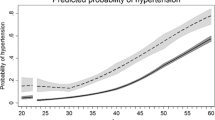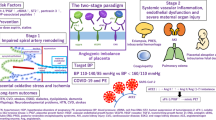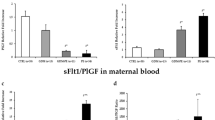Abstract
Hypertensive disorders of pregnancy (HDPs) are associated with altered maternal metabolism, impaired perinatal outcome and increased risk for remote maternal complications. The aim of our study was to analyse associations between circulating levels of angiogenic factors and markers of oxidative stress and metabolic status in women with HDP. Forty-six women in singleton pregnancies complicated by HDP and 30 healthy controls were enrolled in a prospective observational study. Serum concentrations of endothelial nitric oxide synthase (eNOS), angiotensin-converting enzyme, vascular endothelial growth factor (VEGF) and placental growth factor (PlGF) were measured in the third trimester and correlated with maternal anthropometrics and metabolic status. We found significantly lower eNOS levels in patients with severe hypertension vs controls, a strong association between eNOS and PlGF in the study group, a significant association between maternal prepregnancy body mass index (BMI) and VEGF levels and an inverse correlation between VEGF and PlGF. Maternal prepregnancy BMI was the only independent predictor for VEGF concentrations. We noted reduced levels of PlGF and eNOS and increased VEGF levels in women with severe hypertension/preeclampsia. First, different forms of HDP are associated with different alteration patterns in concentrations of angiogenic factors and markers of oxidative stress. Second, maternal prepregnancy BMI, but not body weight, is a significant predictor for VEGF levels in late pregnancy.
This is a preview of subscription content, access via your institution
Access options
Subscribe to this journal
Receive 12 digital issues and online access to articles
$119.00 per year
only $9.92 per issue
Buy this article
- Purchase on Springer Link
- Instant access to full article PDF
Prices may be subject to local taxes which are calculated during checkout





Similar content being viewed by others
References
Lindheimer MD, Taler SJ, Cunningham FG . ASH position paper: hypertension in pregnancy. J Clin Hypertens 2009; 11: 214–225.
Ananth CV, Vintzileos AM . Ischemic placental disease: epidemiology and risk factors. Eur J Obstet Gynecol Reprod Biol 2011; 159: 77–82.
Smith GC, Pell JP, Walsh D . Pregnancy complications and maternal risk of ischaemic heart disease: a retrospective cohort study of 129,290 births. Lancet 2001; 357: 2002–2006.
Irgens HU, Reisaeter L, Irgens LM, Lie RT . Long term mortality of mothers and fathers after pre-eclampsia: population based cohort study. BMJ 2001; 323: 1213–1217.
Hastie CE, Smith GCS, MacKay DF, Pell JP . Maternal risk of ischaemic heart disease following elective and spontaneous pre-term delivery: retrospective cohort study of 750350 singleton pregnancies. Int J Epidemiol 2011; 40: 914–914.
Maynard SE, Min JY, Merchan J, Lim KH, Li J, Mondal S et al. Excess placental soluble fms-like tyrosine kinase (sFlt1) may contribute to endothelial dysfunction, hypertension and proteinuria in preeclampsia. J Clin Invest 2003; 111: 649–658.
Furuya M, Kurasawa K, Nagahama K, Kawachi K, Nozawa A, Takahashi T et al. Disrupted balance of angiogenic and antiangiogenic signallings in preeclampsia. J Pregnancy 2011; 2011: 123717.
Agarwal I, Karumanchi SA . Preeclampsia and the anti-angiogenic state. Pregnancy Hypertens 2011; 1: 17–21.
Maynard SE, Karumanchi SA . Angiogenic factors and preeclampsia. Semin Nephrol 2011; 31: 33–46.
Wolf M, Sandler L, Jimenez-Kimble R, Shah A, Ecker JL, Thadhani R . Insulin resistance but not inflammation is associated with gestational hypertension. Hypertension 2002; 40: 886–891.
Hauth JC, Clifton RG, Roberts JM, Myatt L, Spong CY, Leveno KJ et al. Maternal insulin resistance and preeclampsia. Am J Obstet Gynecol 2011; 204 (4): e1-327–e1-326.
Hoshimoto-Myizawa S, Takahashi K, Bujo H, Hashimoto N, Saito Y . Elevated serum vascular endothelial growth factor is associated with visceral fat accumulation in human obese subject. Diabetologia 2003; 46: 1483–1488.
Elias I, Franckhauser S, Bosch F . New insights into adipose tissue VEGF-A action in the control of obesity and insulin resistance. Adipocyte 2013; 2: 109–112.
Tahergorabi Z, Khazaei M . The relationship between inflammatory markers, angiogenesis and obesity. ARYA Atheroscler 2013; 9 (4): 247–253.
Tranquilli AL, Brown MA, Zeeman GG, Dekker G, Sibai B . The definition of severe and early-onset preeclampsia. Pregnancy Hypertens 2013; 3: 44–47.
Powers RW, Jeyabalan A, Clifton RG, Van Dorsten P, Hauth JC, Klebanoff MA et al. Soluble fms-like tyrosine kinase-1 (sFlt-1), endoglin and placental growth factor (PlGF) in preeclampsia among high risk pregnancies. PLoS ONE 2010; 5: e13263.
Govender L, Mackraj I, Gathiram P, Moodley J . The role of angiogenic, anti-angiogenic and vasoactive factors in pre-eclamptic African women: early- versus late-onset preeclampsia. Cardiovasc J Afr 2012; 23: 153–159.
Erez O, Romero R, Espinoza J, Fu W, Todem D, Kusanovic JP et al. The change in concentrations of angiogenic and anti-angiogenic factors in maternal plasma between the first and second trimesters in risk assessment for the subsequent development of preeclampsia and SGA. J Matern Fetal Neonat Med 2008; 21: 279–287.
Ramma W, Buhimschi I, Zhao G, Dulay AT, Ali Nayeri U, Buhimschi K et al. The elevation in circulating anti-angiogenic factors is independent of markers of neutrophil activation in preeclampsia. Angiogenesis 2012; 15: 333–340.
Bates DO . An unexpected tail of VEGF and PlGF in pre-eclampsia. Biochem Soc Trans 2011; 39: 1576–1582.
Levine RJ, Maynard SE, Qian K, Lim KH, Engladn LJ, Yu KF et al. Circulating angiogenic factors and the risk of preeclampsia. New Engl J Med 2004; 350: 672–683.
Polliotti BM, Fry AG, Saller DN, Mooney RA, Cox C, Miller RK . Second-trimester maternal serum placental growth factor and vascular endothelial growth factor for predicting severe, early-onset preeclampsia. Obstet Gynecol 2003; 10: 1266–1274.
Celik H, Avci B, Isik Y . Vascular endothelial growth and endothelin-1 levels in normal pregnant women an pregnant women with pre-eclampsia. J Obstet Gynecol 2013; 33: 355–358.
Odibo AO, Rada CC, Cahill AG, Goetzinger KR, Tuuli MG et al. First trimester serum soluble fms-like tyrosine kinase-1, free vascular endothelial growth factor, placental growth factor and uterine artery Doppler in preeclampsia. J Perinatol 2013; 33: 670–674.
Rath G, Tripathi R . VEGF and its soluble receptor VEGFR-2 in hypertensive disorders during pregnancy: the Indian scenario. J Hum Hypertens 2012; 26: 196–204.
Sundrani D, Khot V, Pisal H, Mehendale S, Wagh G, Joshi A et al. Gestation dependant changes in angiogenic factors and their associations with fetal growth measures in normotensive pregnancy. PLoS ONE 2013; 8: e54153.
Sezer SD, Kucuk M, Yenisey C, Yuksel H, Odabasi AR, Turkmen MK et al. Comparison of angiogenic and anti-angiogenic factors in maternal and umbilical cord blood in early-onset, and late-onset pre-eclampsia. Gynecol Endocrinol 2012; 28: 628–632.
Akolekar R, de Cruz J, Foidart JM, Munaut C, Nikolaides K . Maternal plasma soluble fms-like tyrosine kinase-1 and free vascular endothelial growth factor at 11 to 13 weeks of gestation in preeclampsia. Prenat Diagn 2010; 30: 191–197.
Semczuk-Sikora A, Krzyżanowski A, Kwiatek M, Semczuk M . Maternal serum concentrations of placenta growth factor (PlGF) and endothelial growth factor in pregnancies complicated by preeclampsia. Ginekol Pol 2007; 78: 873–876.
Tam J, Duda DG, Perentes JY, Qyadri RS, Fukumura D, Jain RK . Blockade of VEGFR2 and not VEGFR1 can limit diet-induced fat tissue expansion: role of local versus bone marrow-derived endothelial cells. PLoS ONE 2009; 4: e4974.
Resi V, Basu S, Haghiac M, Presley L, Minium L, Kauffman B et al. Molecular inflammation and adipose tissue matrix remodeling precede physiological adaptations to pregnancy. Am J Physiol Endocrinol Metab 2012; 303: E822–E840.
Tinahones FJ, Coin-Aragues L, Mayas MD, Garcia-Fuentes E, Hurtado-del-Pozo C, Vendrell J et al. Obesity-associated insulin resistance is correlated to adipose tissue vascular endothelial growth factors and metalloproteinase levels. BMC Physiol 2012; 12: 4.
Lemoine AY, Ledoux S, Larger E . Adipose tissue angiogenesis in obesity. Thromb Haemost 2013; 110: 661–668.
Thadhani R, Ecker JE, Mutter WP, Wolff M, Smirnakis K, Vikas P et al. Insulin resistance and alterations in angiogenesis. additive insults that may lead to preeclampsia. Hypertension 2004; 43: 988–992.
Fusaru AM, Pisoschi CG, Bold A, Taisescu C, Stanescu R, Hincu M et al. Hypoxia induced VEGF synthesis in visceral adipose depots in obese diabetic patients. Rom J Morphol Embryol 2012; 53: 903–909.
Ahmed A, Dunk C, Ahmad S, Kaliq A . Regulation of placental vascular endothelial growth factor (VEGF) and placenta growth factor (PlGF) and soluble FLT-1 by oxygen—a review. Placenta 2000; 21 (Suppl A): S16–S24.
Wolf M, Hubel CA, Lam C, Sampson M, Ecker JL, Ness RB et al. Preeclampsia and future cardiovascular disease: potential role of altered angiogenesis and insulin resistance. J Clin Endocrinol Metab 2004; 89: 6239–6243.
Shaik AP, Sultana A, Bammidi VK, Sampathirao K, Jamil K . A meta-analysis of eNOS and ACE polymorphisms and risk of pre-eclampsia in women. J Obstet Gynecol 2011; 31: 603–607.
Staines-Urias E, Paez MC, Doyle P, Dudbridge F, Serrano NC, Ioannidis JP et al. Genetic association studies in pre-eclampsia: systematic meta-analyses and field synopsis. Int J Epidemiol 2012; 41: 1764–1765.
Aggarval PK, Jain V, Jha V . Endothelial nitric oxydase syntase, angiotensin-converting enzyme and angiotensinogen gene polymorphisms in hypertensive disorders of pregnancy. Hypertens Res 2010; 33: 473–477.
Ringholm L, Pedersen-Biergaard U, Thorsteinsson B, Boomsma F, Damm P et al. A high concentrations of prorenin in early pregnancy is associated with development of preeclampsia in women with type 1 diabetes. Diabetologia 2011; 54: 1615–1619.
Sykes SD, Pringle KG, Zhou A, Dekker GF, Roberts CT, Lumbers ER . Fetal sex and the circulating rening-anigotensin system during early gestation in women who later develop preeclampsia or gestational hypertension. J Hum Hypertens 2013; 28 (2): 133–139.
Acknowledgements
This study was funded by a research grant N N407 187936 from Polish Ministry of Science.
Author information
Authors and Affiliations
Corresponding author
Ethics declarations
Competing interests
The authors declare no conflict of interest.
Rights and permissions
About this article
Cite this article
Zawiejska, A., Wender-Ozegowska, E., Iciek, R. et al. Concentrations of endothelial nitric oxide synthase, angiotensin-converting enzyme, vascular endothelial growth factor and placental growth factor in maternal blood and maternal metabolic status in pregnancy complicated by hypertensive disorders. J Hum Hypertens 28, 670–676 (2014). https://doi.org/10.1038/jhh.2014.42
Received:
Revised:
Accepted:
Published:
Issue Date:
DOI: https://doi.org/10.1038/jhh.2014.42



